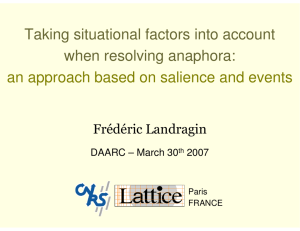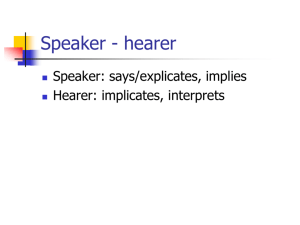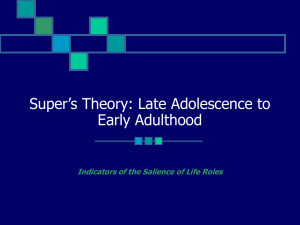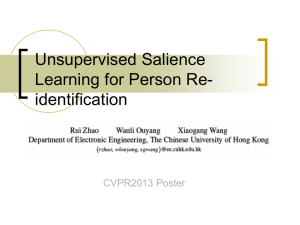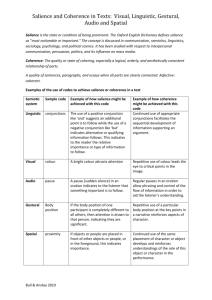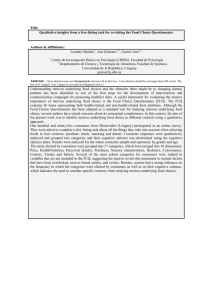Salience in Language Production
advertisement
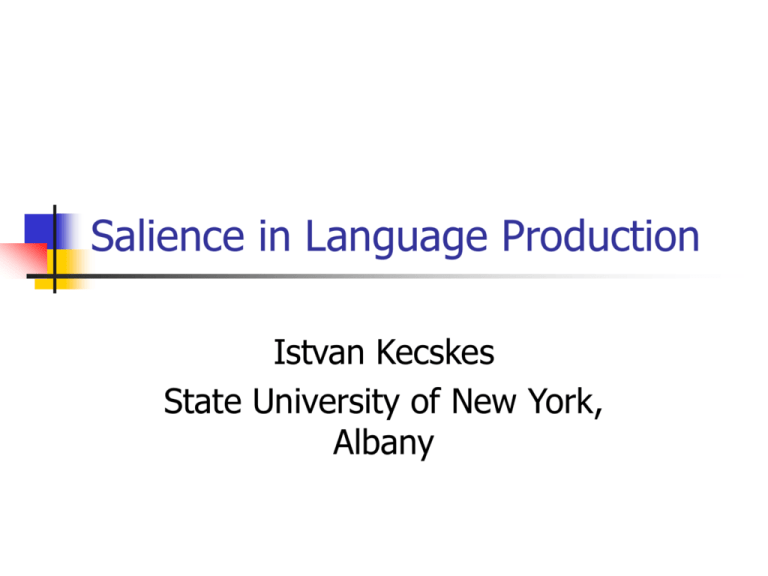
Salience in Language Production Istvan Kecskes State University of New York, Albany The Question Why exactly do we say what we say the way we say it? What to do to answer the question? Examine what salience is in a sociocognitive framework. Discuss salience as a guiding mechanism in language production. A socio-cognitive framework Synthesis of cooperation-centered view of communication and the egocentrism-based cognitive psychological approach. SCA supports a less idealized, more down-to-earth approach to communication than current pragmatic theories usually do. While not denying the decisive role of cooperation, context and politeness in communication, SCA gives equal importance to egocentrism, linguistic aggression, and the untidy, trial-and-error nature of communication. Main tenets of the socio-cognitive approach SCA emphasizes that interlocutors are not only constrained by societal conditions but also shape these conditions at the same time. It considers communication a process of the interplay of cooperation and egocentrism that are present in all phases of interaction to a varying extent. While cooperation is an intention-directed practice measured by relevance, egocentrism is an attention-oriented trait measured by salience. Egocentrism: attention-salience Language processing is anchored in the assumption that what is salient or accessible to oneself will also be accessible to one’s interlocutors (Giora 2003; Barr & Keysar 2005; Colston 2005; Kecskes 2007). Egocentrism means that interlocutors activate the most salient information to their attention in the construction (speaker) and comprehension (hearer) of utterances. Conceptual accessibility Conceptual accessibility is the ease with which the mental representation of some potential referent can be activated in or retrieved from memory (Bock & Warren, 1985; Ariel 1991, 2000). Several accessibility theories have been developed to explain how the accessibility of entities affects the form of referring expressions, as in the Givenness Hierarchy (Chafe 1976; Givón 1992), Ariel’s Accessibility Theory (Ariel 1991;2000) or how it affects the local coherence of discourse, as in Centering Theory (Grosz and Sidner 1986; Grosz et al., 1995; Wlodarczyk, A & Wlodarczyk, H. 2006) and Jaszczolt’ concept of “semantic default” (2005). Accessibility depends on salience, selective attention and situational context. What is salience? As a semiotic notion, salience refers to the relative importance or prominence of signs. The more prominent/important a sign is the more accessible it is. Salience is the most important factor that affects the accessibility level of entities in interlocutors’ memory. (Most probable out of all possible.) SCA: Both speakers and hearers rely on their most accessible and salient knowledge expressed in language production and interpretation. Graded Salience Hypothesis Focuses on meaning salience in comprehension. Meaning salience refers to degree of entrenchment of meanings listed in our mental lexicon. Stored information is superior to unstored information, such as novel information or information inferable from context (Giora, 2003:15). Salient meanings of lexical units (e.g., conventional, frequent, familiar, and/or prototypical meanings) are processed automatically, irrespective of contextual information and strength of bias. (Giora, 2003: 24). Differences between SCA and the graded salience hypothesis GSH basically is hearer-centered, while SCA focuses on both production and comprehension. GSH focuses on meaning salience that predicts the degree of accessibility of meanings in a speaker’s or hearer’s memory and how this accessibility affects the production and interpretation of language. GSH emphasizes the importance of stored information, while SCA considers salience to be both a stored (inherent salience) and an emergent entity (emergent situational salience). While GSH uses ‘context’ in the sense of actual situational context, SCA emphasizes the difference and interplay between prior context, encapsulated in utterance formulation, and actual situational context. Speaker salience may differ from hearer salience The speaker will use the linguistic resources (e.g., lexical units, syntactic structures) which s/he thinks are most salient for expressing his/her communicative intentions and/or goals; Because of their different knowledge base, the frequency/rituality of their knowledge in the situation, and the attentional resources available to them for processing the salient items, the interlocutors’ knowledge has different levels of salience. Susie and Roy Roy: - Is there something wrong, Susie? Susie: - I am fine, Roy. Roy: - I would have believed you if you hadn’t said “Roy”. Susie: - OK, OK, just stop…… Speaker’s commitment By producing an utterance the speaker makes a commitment to some information or action s/he can be held accountable for. However, the degree of speaker’s commitment and accountability varies between saying and implying. Haugh (2010) argued that where two (or more) interlocutors co-construct what is said, the speaker generally holds him/herself accountable for that interpreting, while in the case of implying, where two (or more) interlocutors co-construct an implicature, the degree to which the speaker should hold him/herself accountable for that interpreting is often more open to discussion. Haugh added that he did not want to suggest that speakers are always held less accountable for meanings achieved through implying, because implicatures cannot always be legitimately cancelled (Burton-Roberts 2006; Jaszczolt 2009). As a result, they conduct the attentional processing of communication in an egocentric manner. Chris’ friend Peter arrived by plane and Chris met him on the airport. Chris: - Are you hungry? Peter: - I had something to eat on the plane. I am OK. Chris: - All right. Let’s go to a Wendy’s. Possible interpretations: kind of hungry, not hungry, don’t really know Bock & Levelt’s production model The model includes three levels or stages of sentence generation distinguished as (1) MESSAGE component, (2) GRAMMATICAL component, and (3) PHONOLOGICAL component, or ARTICULATOR (see Figure 1 adopted from Bock & Levelt, 1994). Processing Communicative intention is created. This intention is called a message. At the message stage, pre-verbal thought (intention) is processed, and organized into a conceptual scheme of the event before any linguistic processing occurs. It is at this message level where salience comes in as an important factor. Salience effects are supposed to be the most active here biasing conceptualization of the event according to the event’s salience map. The message captures features of the speaker’s intended meaning and provides the raw material for grammatical encoding. Selection and ordering What determines the selection of words to put the preverbal thoughts into? Past and current research has focused mainly on the formal and structural issues of selection and ordering asking the questions: What facilitates the choice of a structure and the ordering of the sentence constituents during the production of utterances? However, according to SCA conceptualization and the concept/word (lemma) interface plays a crucial role in shaping structures. Selected words require/facilitate particular structures and not vice versa. Structural variability depends on the selected words. Salience in production Evidence from some previous studies points to the role of salience and the distribution of attention in planning and formulation of sentences (e.g. Myachykov 2007; Tomlin 1997; Stevenson 2002). Allen & Charlie: - Morning.. - What’s so good about it? - I did not say “good”. Theme and rheme, topic and comment The role of salience and distribution of attention as primary factors affecting selection and ordering is somewhat contradicts to the traditional view commonly shared in linguistics: “The (sentence) constituents move to certain positions because of their discourse function interpretation (King, 1995, 63).” This approach is based on the assumption that the assignment of the syntactic positions in a clause depends on the functional opposition between clause-level theme and rheme, topic and comment, and/or the referents’ semantic roles, like agent and patient. Traditionally, starting from the Prague school of linguistics (e.g. Mathesius, 1929; Firbas, 1965; Daneš, 1970) continuing with Halliday (1985) the notion of theme is associated with the element “what one is talking about, the topic,” while the rheme is “what one says about it, the comment” (Daneš, 1970). In this framework the subject of a sentence frequently acts as the syntactic counterpart of the theme or topic of the utterance. The information flow in discourse: old or given information and new information. Givenness represents the knowledge shared between the interlocutors. Consequently, the given information is that which the speaker believes to be known by the hearer. In contrast, the new information is the information the speaker is unfamiliar with (cf. Clark & Haviland, 1977; Halliday, 1967/1968, Haviland & Clark, 1974). A quasi-psychological view on givenness suggests that given (old) versus new distinction correlates with the notion of cognitive activation of the concept. Problems - The approach is based on a priori mental state and intention and ignores the emergent features of salience and intention. - The speaker’s cognitive egocentrism hardly depends on any assumption about the state of the mind of the hearer. So newly introduced information may or may not be new to the hearer at all. - Both speaker and hearer are influenced by three types of salience. Bob & Sally Bob: - Will you have lunch with me today? Sally: - Sorry, I can’t. I will have to pick up my sister at the airport. Bob: - Oh, you have a sister, don’t you? Salience in the socio-cognitive approach Inherent salience is characterized as a natural preference built into the general conceptual- and linguistic knowledge of the speaker-hearer; it has developed as a result of prior experience with lexical items and contexts. This is closed to what Giora (2003) calls “meaning salience”. Collective salience is conceptual preference attached to a linguistic unit shared with the other members of the speech community, and changes diachronically. Emergent situational salience refers to the salience of specific objects and linguistic elements in the context of language production. Situational salience may accrue through such determinants as vividness, speaker-hearer motivation, and recency of mention. Inherent salience is affected and shaped both by collective and situational salience Jill: - I met with someone today. Jane: - Good for you. Jill: - He is a police officer. Jane: - Are you in trouble? Jill: - Oh, no….. Emergent situational salience Refers to the salience of situational constraints that can derive from factors such as obviousness, vivideness, recency of mention, and others. The cashier’s “how are you doing today?” question in a supermarket requires only a short “fine, thank you”. The salience of the situation makes the function of the expression obvious. However, ESS can be overridden by both collective salience and inherent salience. Sign on the door of a department store: “Girls wanted for different positions.” Competition between inherent and emergent situational salience Osgood and Bock (1977) found that elements of inherent salience have a stronger effect on ordering than elements of motivated emergent salience. This claim basically coincides with what Giora says in her graded salience hypothesis (Giora 1997; 2003). Focused first versus old-before-new in SCA Bock, Irwin, & Davidson (2004) claimed, that “the focused first” and “the old first” proposals are contradictory because the information that attracts the focus of attention is typically the new elements of the scene, whereas givenness promotes the already established background. The lexical-semantic factors (e.g. old-before-new) and the perceptual factors (e.g. focused/attended first) should, therefore, produce competing effects. Prior experience also plays some role in attention-getting, i.e., what the focus of attention becomes. Inherent salience (oldbefore-new) and emergent situational salience (focused-first) are intertwined and affect each other continuously in the communicative process. The strongest communicative effect is reached when there is no competition between the two. No competition Not only emergent situational salience but also perceptual inherent salience direct (especially males’) attention to the girl in the advertisement. The note “girl not included” aims to decrease or cancel this powerful saliency. Male mind-set, based on prior experience directs attention to the female character just like actual situational salience does. This affect, however, may not be present in the case of female recipients, which demonstrates the different privatization of saliency. Conclusion Salience affects not only comprehension but also production. Language processing is anchored in the assumption that what is salient or accessible to oneself will also be accessible to one’s interlocutors (egocentrism). Selection is motivated by the interplay of inherent, collective salience and emergent situational salience. The role of salience and distribution of attention as primary factors in selection and ordering somewhat contradicts to the traditional view according to which (sentence) constituents move to certain positions because of their discourse function interpretation. Relationship of salience to theme/rheme and topic/comments needs further research. Literature Kecskes, I. 2010. The paradox of communication: A socio-cognitive approach. Pragmatics & Society. Vol. 1. No. 1: 50-73 Kecskes, I. 2010. Situation-Bound Utterances as Pragmatic Acts. Journal of Pragmatics. Vol. 42. No. 11: 2889-2897. Kecskes, I. & F. Zhang. 2009. Activating, seeking and creating common ground: A socio-cognitive approach. Pragmatics & Cognition. Vol. 17. No. 2: 331-355. Kecskes, Istvan and Jacob Mey. (eds.) 2009. Intention, Common Ground and the Egocentric Speaker-Hearer. Berlin/New York: Mouton de Gruyter. Kecskes, I. 2008. Dueling context: A dynamic model of meaning. Journal of Pragmatics. Vol. 40. Issue 3: 385-406.
